Menu

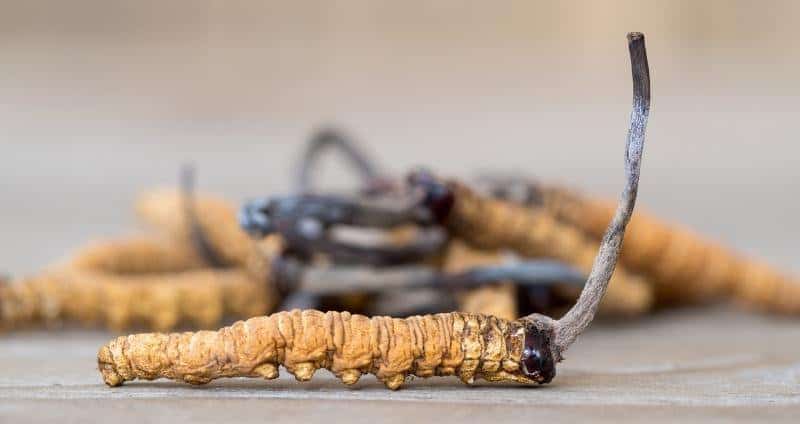
Cordyceps are fascinating fungi since they are present in Chinese herbal medicine while also having an odd method of multiplying using a dead caterpillar or similar organisms.
From how they take over caterpillars and other insects to their numerous health benefits and hefty price tag. It’s no surprise you’re curious about them.
To help bring clarity between the myth and the science behind this strange but helpful parasitic mushroom we’ve answered 30 questions on caterpillars with cordyceps (a.k.a. Cordyceps sinensis). As you go through our list, you’ll learn:
How to spot a genuine Cordyceps product
The stalk-like, dark brown, fruiting body of Cordyceps (stroma), which grows out of a caterpillar head, is edible along with the non-fruiting body (sclerotium).
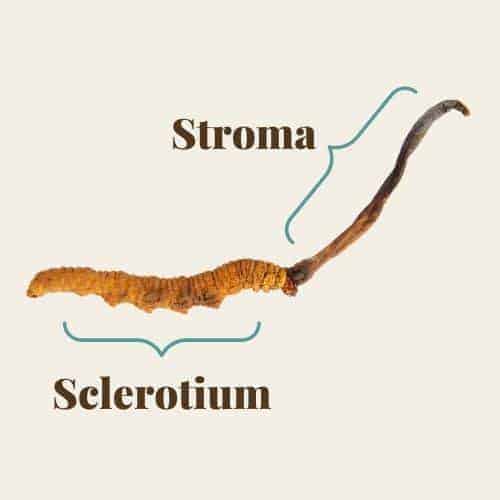
Cordyceps sinensis is a well-known herbal remedy in East Asia. They’re loaded with beneficial bioactive compounds such as cordycepin and adenosine.
The ground-dwelling caterpillars of ghost moths are prone to infection by Cordyceps sinensis.
These caterpillars mostly dwell just below the ground surface of shrublands and alpine grasslands, perfect environments for the fruiting cordyceps fungus.
Most ghost moth caterpillars populate the shrublands and grasslands of the Tibetan plateau and the Himalayas at an altitude of between 9,800 and 16,400 feet.
More specifically, these caterpillars are found in the mountainous regions of:
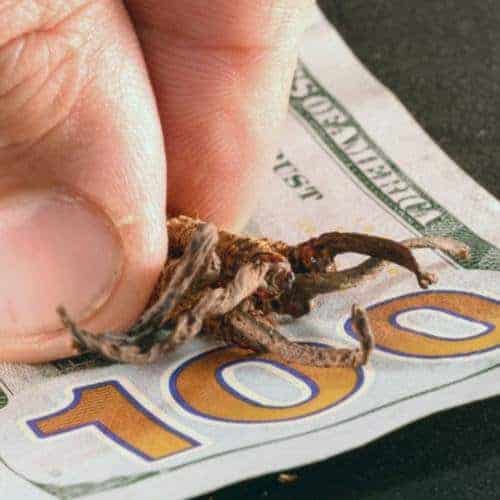
Cordyceps sinensis (a.k.a caterpillars with cordyceps) are expensive because they’re notoriously hard to find and have high demand.
Their hard-to-find status is because they sprout only a few weeks a year—in the spring—which isn’t enough time to satisfy year-round, global demand. And, unlike other types of cordyceps mushrooms, which can grow out of a variety of insects, Cordyceps sinensis grows from only a single species of moth: the ghost moth.
Additionally, the natural habitat of these caterpillars—grasslands—keeps them hidden like needles in a haystack. Since no one has yet been able to figure out how to cultivate this kind of cordyceps, they remain rare.
Ophiocordyceps sinensis is commonly referred to as the caterpillar fungus. It is an entomopathogenic fungus (a parasite of insects) that often infects the caterpillar of ghost moths.
It’s the wild cordyceps species with a long history in Traditional Chinese Medicine (TCM) and the inspiration behind modern cultivated cordyceps alternatives.
The relationship between caterpillars and cordyceps fungus is purely parasitic and propagating to the fungus.
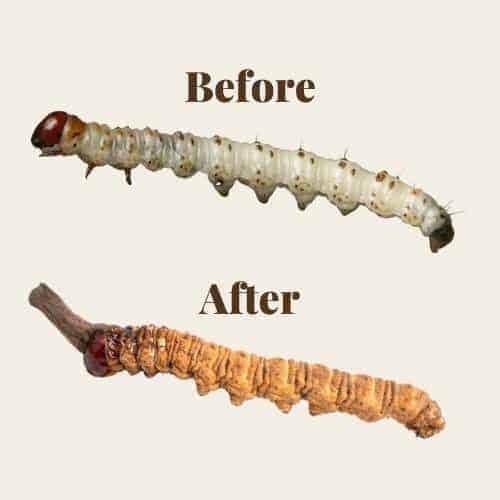
Cordyceps sinensis (a.k.a. caterpillar cordyceps) may support your body in the following ways:
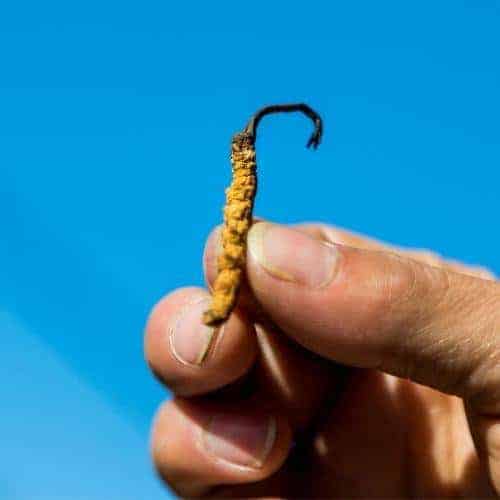
Caterpillars with cordyceps (a.k.a. Cordyceps sinensis) are bright yellow when harvested with longitudinal ridges across their sclerotium (the non-fruiting body) with a thin blade-like mushroom protruding from its head.
Cordyceps mushrooms are longer than the caterpillar’s body and dark brown when harvested but eventually darken when dry.
Harvesting Cordyceps sinensis is a communal practice that involves manually searching through large tracts of alpine grasslands for the protruding mushrooms popping out of the ground.
The practice is generally low-tech and occurs in the spring when the fungus emerges from the soil, ready to infect more caterpillars.
Processing caterpillar cordyceps involves the following methods:
Due to the high price tag, wild Cordyceps sinensis is typically bought as a gift, and the majority of sales are made in China.
Caterpillars with cordyceps (a.k.a. Cordyceps sinensis) have no psychedelic properties. They are adaptogenic, meaning they support your body's resistance to stressors and promote normal physiological functioning.
For instance, they can help your body with oxidative stress while promoting a healthy response to inflammation.
In Traditional Chinese Medicine and much of the Himalayas region, Cordyceps sinensis mushrooms have long been used as natural aphrodisiacs for men and women, hence the name “Himalayan viagra.”
To date, scientific studies have supported this practice. For instance, one study found caterpillars with cordyceps to enhance libido by 66% [1].
Warming winters and declining snowfall are greatly impacting the population of the caterpillar mushroom (a.k.a. Cordyceps sinensis). Recently, China reported a drastic decline in yields due to global warming.
Meanwhile, across the Himalayas, a major source of the world’s caterpillar fungus, a 20%–40% reduction in snowfall is predicted. This will likely exacerbate the already dwindling numbers of caterpillar Cordyceps.
There are a variety of important nutritional components in Cordyceps sinensis (Hyun 2008; Yang et al. 2009, 2010; Li et al. 2011), including:
Cordyceps sinensis, the true caterpillar fungus, cannot be grown without the caterpillars. After many decades of trying to cultivate Cordyceps sinensis in China, only recently has this been accomplished by initially farming the ghost moth and then infecting it with Cordyceps sinensis mycelium.
Cordyceps militaris, on the other hand, can be cultivated on conventional mushroom substrates without the need for its’ native insect host.
Caterpillar cordyceps develop their mushroom (fruiting body) annually in the spring. The following table highlights this process throughout the year.

The mushroom (fruiting body) of Cordyceps sinensis, which sprouts from the head of dead caterpillars, contains many biologically active compounds, for instance:
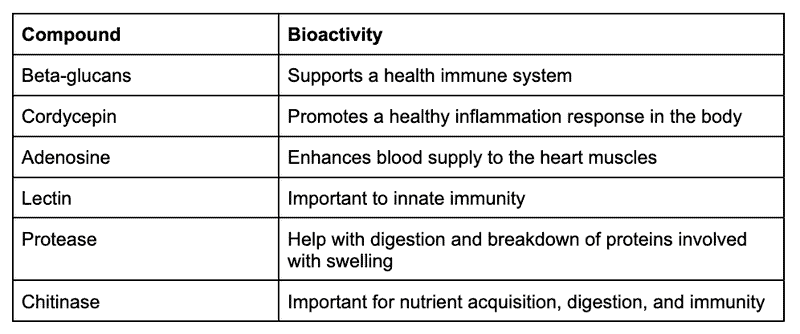
Out of these, beta-glucans and cordycepin are the primary active compounds and the most studied, with a wide range of biological activity.
Ghost moth caterpillars themselves are not endangered. However, the Cordyceps sinensis fungi that infect and grow out of the corpses of ghost moth caterpillars is an endangered species and highly restricted.
Their endangered status is due to overexploitation for use in traditional medicines, as well as an ever-changing climate in the wild harvesting regions.
While ghost moth caterpillars are prone to infection by Cordyceps sinensis, they aren’t the only victims.
Other species of cordyceps also parasitize the insect orders Hymenoptera, Hemiptera, and Coleoptera. The following table highlights the various features of these insect orders.
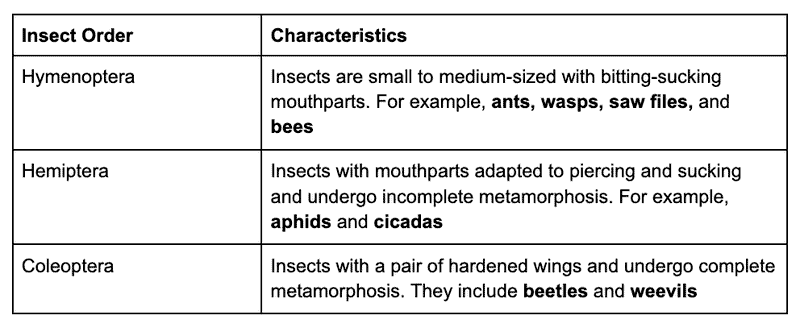
Caterpillars infected with cordyceps contain carotenoids, which are responsible for their intense yellow-orange color.
Carotenoids are light-harvesting pigments produced by plants, algae, and fungi that double as antioxidants in humans. These pigments extend the spectral range over which photosynthesis can occur.
Carotenoids are also present in:
<h2id="question21">21. Are Cordyceps Supplements as Good as Caterpillars With Cordyceps?
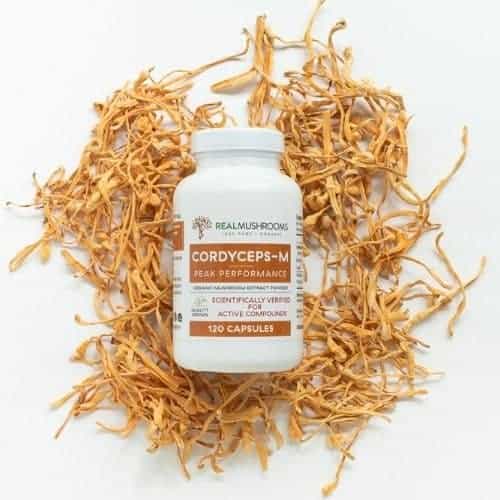
Cordyceps supplements by Real Mushrooms use the militaris species of cordyceps instead of sinensis. Why? Because the sinensis species is controversial on many levels and cannot be cultivated at scale. Luckily, Cordyceps militaris boasts even higher concentrations of the health-supporting compound, Cordycepin, than the caterpillar cordyceps.
Commercially-available cordyceps supplements are generally made exclusively from the cultivated cordyceps of the species militaris. There are three reasons for this:
However, some commercial Cordyceps militaris supplements contain only the fungal mycelium and not the mushroom. To receive adequate concentrations of the health-supporting compounds from cordyceps, it is important that the supplement contains the actual mushroom.
Here’s one such supplement by Real Mushrooms that only features the mushroom of cultivated Cordyceps militaris. No added starch, mycelium, or grain of any kind ensures high amounts of bioactive compounds for maximum health benefits.
"These supplements helped me with cognitive and physical benefits. They are not mixed with fillers and have no weird taste." My Linh

Considering their endangered status, harvesting and trading of caterpillars with cordyceps is highly restricted and outright banned in some countries such as India. Recently, India’s state of Sikkim acquired sniffer dogs to help enforce the ban.
These measures are in place to preserve the population of caterpillars with cordyceps in the wild and prevent potential turf-related conflicts in countries such as Nepal.
Because all cordyceps species parasitize insects, it can be difficult to artificially cultivate them.
While the Chinese have been trying to cultivate Cordyceps sinensis since the 1980s, only recently has there been success. Initial attempts at cultivating the mycelium via liquid fermentation has given rise to cordyceps Cs-4 but the mushroom was never able to be reproduced at scale. This was until scientists added host moth into the equation. By farming the caterpillar and inoculating it with Cordyceps sinensis mycelium as well as simulating the cold mountainous environment, the caterpillar is able to produce the mushroom.
However, this process is still new and quite expensive, so it has not yet reached mass scale.
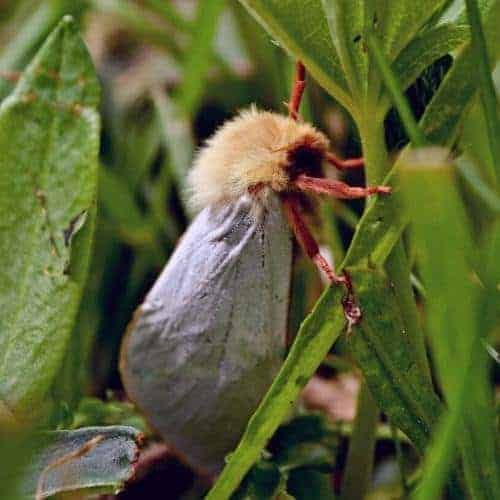
Infecting the caterpillar of the ghost moth with cordyceps spores is the only way that the highly revered Cordyceps sinensis mushroom can be produced.
The cordyceps fungi that infect caterpillars are most productive under cold conditions and grow in areas with permafrost, a thick layer of soil that remains frozen throughout the year.
Such areas are mountainous regions with elevations of between 3,200 and 4,900 meters.
Many cordyceps-harvesting countries have taken measures to try to curb the excessive exploitation of Cordyceps sinensis.
For instance, China is a major producer of Cordyceps militaris mushrooms, which can be cultivated without the use of insects. This is an amazing affordable alternative to the caterpillar fungus.
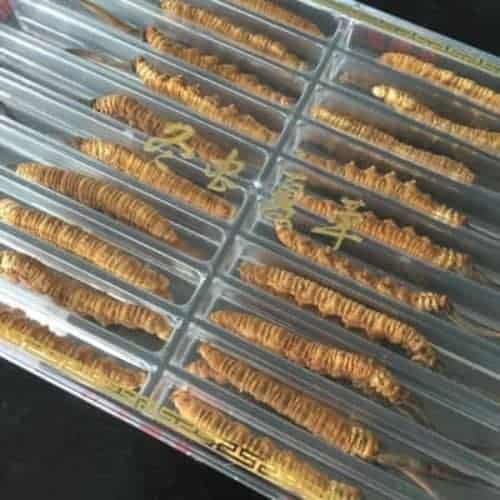
China is also cultivating Cordyceps sinensis but it still requires the host moth and the price tag is still quite high to capitalize on the high price of wild version.
The price tag of wild Cordyceps sinensis is still very high, which currently sits at over $20,000 per kilo.
The caterpillar cordyceps trade has been both a blessing and a curse for the rural communities that inhabit the mountainous alpine grasslands in Asia―where the fungi grow.
On the one hand, the lucrative trade has provided a much-needed income source for these remote communities.
On the other, the cordyceps trade is a major source of conflicts over territorial claims.
For instance, in one Tibetan village, eight locals were found dead after a quarrel over harvesting rights.
In 1993, Chinese track and field runner, Junxia Wang, broke several world records. Her coach, Junren Ma, later credited a tonic of Cordyceps sinensis and turtle blood for Wang’s impressive performance, sparking international attention and demand. Years later, Junren Ma was removed from the Chinese Olympic team due to his athletes failing drug tests.
Today, the fungus is highly exploited for its wide range of benefits, such as increased energy, antioxidation, and respiratory support. As such, mycologists fear that the wild fungus might soon disappear.
Contrary to popular zombie lore, the cordyceps fungi aren’t mind-controlling. They control their hosts, such as caterpillars, by interfering with their nervous system and taking over their muscles.
This is how the fungus gets the caterpillar to burrow itself a few inches beneath the ground surface with its head up. This position facilitates the eventual growth of the cordyceps’ fruiting body.
The prevalence of caterpillars with cordyceps in traditional medicine has led to the development of a lab-grown alternative with similar bioactive compounds, the first example being cordyceps Cs-4.
This cultivated alternative is developed by growing pure cordyceps mycelium in a liquid substrate.
Since then, a much bigger breakthrough has been the development of Cordyceps militaris mushrooms without the need for the host insect. This allows for commercial mushroom growers to vastly scale mushroom production to meet worldwide demand while alleviating the demand on the limited wild supply.

Cordyceps fungi infect caterpillars in the following way:

1. Wang, S. M., Lee, L. J., Lin, W. W., & Chang, C. M. (1998). Effects of a water-soluble extract of Cordyceps sinensis on steroidogenesis and capsular morphology of lipid droplets in cultured rat adrenocortical cells. Journal of cellular biochemistry, 69(4), 483-489.
2. Paterson, 2008; Zhong et al., 2009; Lo et al., 2012; Yan et al., 2014
Disclaimer: The information or products mentioned in this article are provided as information resources only, and are not to be used or relied on to diagnose, treat, cure, or prevent any disease. This information does not create any patient-doctor relationship, and should not be used as a substitute for professional diagnosis and treatment. The information is intended for health care professionals only. The statements made in this article have not been evaluated by the Food and Drug Administration. Any products mentioned are not intended to diagnose, treat, cure, or prevent any disease. The information in this article is intended for educational purposes. The information is not intended to replace medical advice offered by licensed medical physicians. Please consult your doctor or health practitioner for any medical advice.